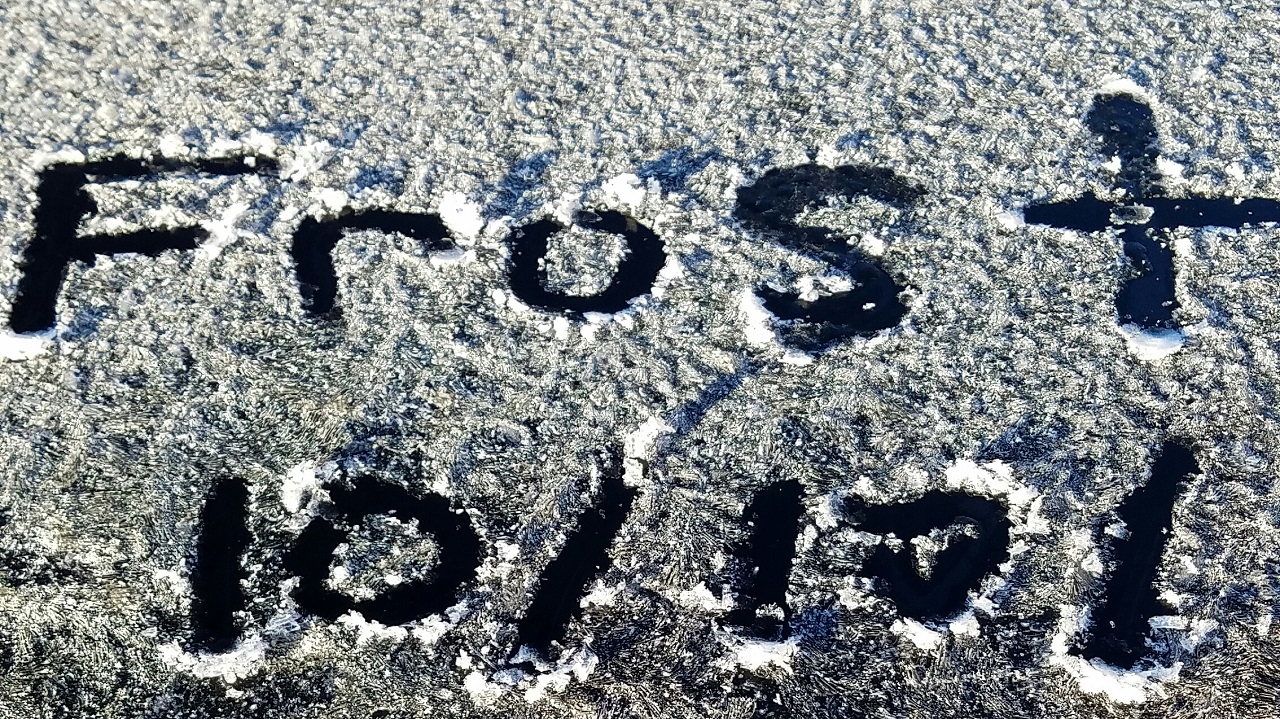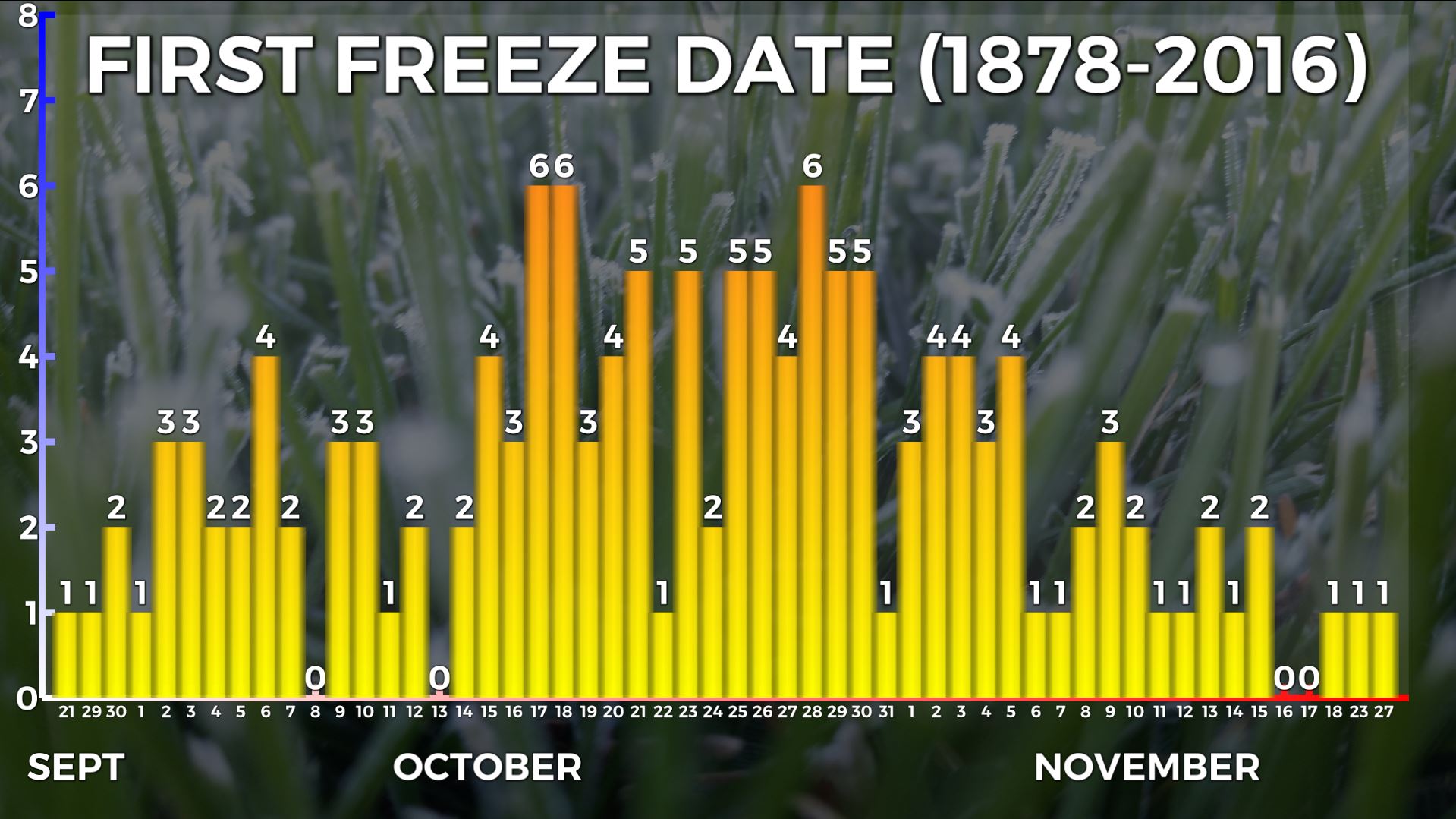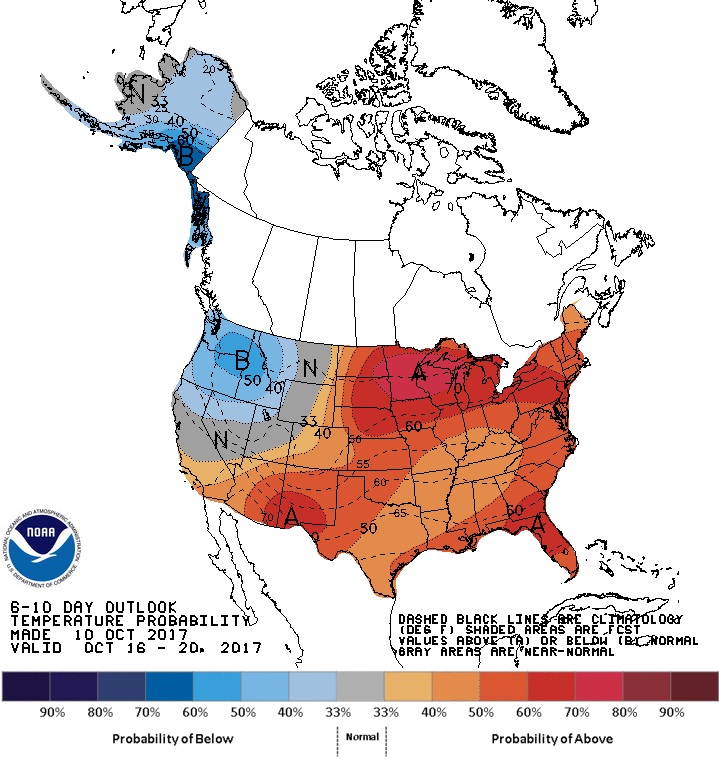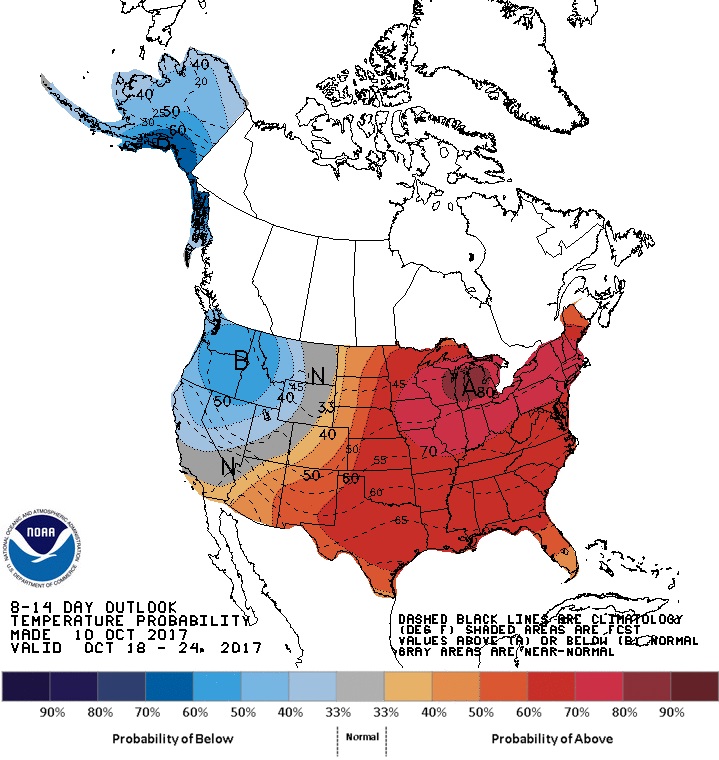COLUMBUS (WCMH) – We have officially entered into fall, and the month of October, the period where temperatures start to make the turn downward. This is also the month where many of us start to see our first frost or freeze.

I took this picture above last year, and put the date on, because I wanted to make sure I remembered next year (now) when we had our first frost last season. I also took a picture of my thermometer, which read a morning low of 34°.It is important to note, the first frost and freeze are not the same thing. So why can we have frost above 32°?
On generally clear nights, with no wind and a cooler airmass in place this time of the year, it makes for ideal conditions for cooling. As we know from taking a hot shower, the warm/moist air is lighter than the cold/dry air, and it will rise. The heavier cold air will sink down to the near the ground. Weather instruments for official reporting are taken approximately 5 feet above the ground.
So on a cold night, the official temperature for a location might read as warm as 35° or 36°, yet there will be frost on the ground below where the temperature is at or below freezing (32°).
It is also important to note, that we can have a freeze without a frost in dry conditions.When do we normally see our first freeze?
This is something we keep track of for several reporting cities in our area, and the short answer is, it depends. But in general most cities see their first freeze in the month of October.
According to the National Weather Service in Wilmington, our average first freeze date in Columbus is one of the latest in Central and southern Ohio (October 27th).
The NWS has listed some of our other cities that they have data for, and their first freeze dates:
| Bellefontaine | 14-Oct | |
| Chillicothe | 17-Oct | |
| Circleville | 19-Oct | |
| Delaware | 14-Oct | |
| Kenton | 20-Oct | |
| London | 9-Oct | |
| Marysville | 22-Oct | |
| Newark | 12-Oct | |
| Washington Court House | 21-Oct |
While the normal for first freeze dates in Columbus is October 27th, we have had a wide range of dates:
The earliest have been in late September, and the latest dates (like last year) well into November. Last year marked only the 2nd time that we had our first freeze date on November 10th. In fact, there were only 10 years were the 1st freeze were later than we had last year.

Are we expecting a frost or freeze anytime soon here in Central Ohio?
No, not in the next week! We are going to continue to stay quite warm over the next week. We have a cold front that will arrive late Sunday into Monday morning. But this front is only going to bring temperatures back to normal. This means highs in the mid/upper 60s and lows in the lower to middle 40s. Hardly frost range.
Also, below is the 6-10 day outlook from the Climate Prediction Center at NOAA. It shows very good chances that temperatures will remain above normal during this period.

The 8-14 day outlook from the Climate Prediction Center at NOAA does not show much chance for below normal temperatures either.

If this outlook does hold, it means most locations in Central Ohio will be past their average first freeze date. At this point it is way too soon to say if we are going to see record late dates, and in fact, we would have to get past Thanksgiving to do so.How long will frost/freeze warnings be issued?
The National Weather Service offices are the ones that issue these warnings, and they are mainly for agricultural interests. In general the NWS will issues these warnings either until a county has had a widespread hard freeze, or a specific date has been reached. For most areas that date in November 1st, but there are a few counties from Franklin county down south along US-23 and the southern part of the state that warnings can be issued until the end of the first week of November.Here is a complete list since 1878 of all the first freeze dates for Columbus:
| year | month | date |
| 2016 | nov | 10 |
| 2015 | oct | 17 |
| 2014 | nov | 2 |
| 2013 | oct | 25 |
| 2012 | oct | 11 |
| 2011 | oct | 29 |
| 2010 | oct | 30 |
| 2009 | oct | 18 |
| 2008 | oct | 22 |
| 2007 | nov | 23 |
| 2006 | oct | 15 |
| 2005 | oct | 29 |
| 2004 | nov | 9 |
| 2003 | oct | 3 |
| 2002 | nov | 1 |
| 2001 | oct | 18 |
| 2000 | oct | 29 |
| 1999 | oct | 25 |
| 1998 | oct | 23 |
| 1997 | oct | 21 |
| 1996 | nov | 2 |
| 1995 | oct | 17 |
| 1994 | oct | 28 |
| 1993 | oct | 23 |
| 1992 | oct | 17 |
| 1991 | oct | 16 |
| 1990 | oct | 26 |
| 1989 | oct | 9 |
| 1988 | oct | 6 |
| 1987 | oct | 4 |
| 1986 | nov | 3 |
| 1985 | nov | 8 |
| 1984 | nov | 2 |
| 1983 | oct | 27 |
| 1982 | oct | 17 |
| 1981 | oct | 3 |
| 1980 | oct | 6 |
| 1979 | oct | 14 |
| 1978 | oct | 17 |
| 1977 | oct | 16 |
| 1976 | oct | 17 |
| 1975 | oct | 3 |
| 1974 | oct | 2 |
| 1973 | nov | 4 |
| 1972 | oct | 19 |
| 1971 | nov | 4 |
| 1970 | oct | 16 |
| 1969 | oct | 15 |
| 1968 | oct | 5 |
| 1967 | oct | 20 |
| 1966 | oct | 21 |
| 1965 | oct | 5 |
| 1964 | oct | 6 |
| 1963 | sep | 30 |
| 1962 | sep | 21 |
| 1961 | sep | 29 |
| 1960 | oct | 21 |
| 1959 | oct | 18 |
| 1958 | oct | 29 |
| 1957 | oct | 20 |
| 1956 | nov | 13 |
| 1955 | oct | 25 |
| 1954 | oct | 20 |
| 1953 | oct | 30 |
| 1952 | oct | 4 |
| 1951 | oct | 9 |
| 1950 | oct | 26 |
| 1949 | oct | 27 |
| 1948 | oct | 18 |
| 1947 | nov | 9 |
| 1946 | nov | 18 |
| 1945 | nov | 3 |
| 1944 | nov | 5 |
| 1943 | nov | 4 |
| 1942 | oct | 26 |
| 1941 | nov | 9 |
| 1940 | nov | 7 |
| 1939 | oct | 15 |
| 1938 | oct | 31 |
| 1937 | oct | 14 |
| 1936 | oct | 27 |
| 1935 | oct | 7 |
| 1934 | oct | 28 |
| 1933 | oct | 26 |
| 1932 | nov | 11 |
| 1931 | nov | 6 |
| 1930 | oct | 19 |
| 1929 | nov | 5 |
| 1928 | oct | 30 |
| 1927 | nov | 5 |
| 1926 | oct | 25 |
| 1925 | oct | 10 |
| 1924 | oct | 23 |
| 1923 | oct | 23 |
| 1922 | nov | 10 |
| 1921 | nov | 3 |
| 1920 | oct | 30 |
| 1919 | nov | 5 |
| 1918 | nov | 2 |
| 1917 | oct | 20 |
| 1916 | nov | 14 |
| 1915 | nov | 15 |
| 1914 | oct | 26 |
| 1913 | oct | 21 |
| 1912 | nov | 1 |
| 1911 | oct | 28 |
| 1910 | oct | 28 |
| 1909 | oct | 12 |
| 1908 | oct | 2 |
| 1907 | oct | 21 |
| 1906 | oct | 10 |
| 1905 | oct | 30 |
| 1904 | oct | 28 |
| 1903 | oct | 24 |
| 1902 | nov | 27 |
| 1901 | oct | 18 |
| 1900 | nov | 8 |
| 1899 | oct | 1 |
| 1898 | oct | 27 |
| 1897 | nov | 12 |
| 1896 | oct | 19 |
| 1895 | oct | 10 |
| 1894 | oct | 15 |
| 1893 | oct | 29 |
| 1892 | oct | 6 |
| 1891 | oct | 23 |
| 1890 | nov | 1 |
| 1889 | oct | 7 |
| 1888 | sep | 30 |
| 1887 | oct | 12 |
| 1886 | oct | 2 |
| 1885 | oct | 9 |
| 1884 | oct | 24 |
| 1883 | nov | 3 |
| 1882 | nov | 13 |
| 1881 | nov | 15 |
| 1880 | oct | 18 |
| 1879 | oct | 25 |
| 1878 | oct | 28 |
If you have questions about frosts/freezes, cold temps, climate, or any other weather questions, email me, dmazza@wcmh.com
-Dave










